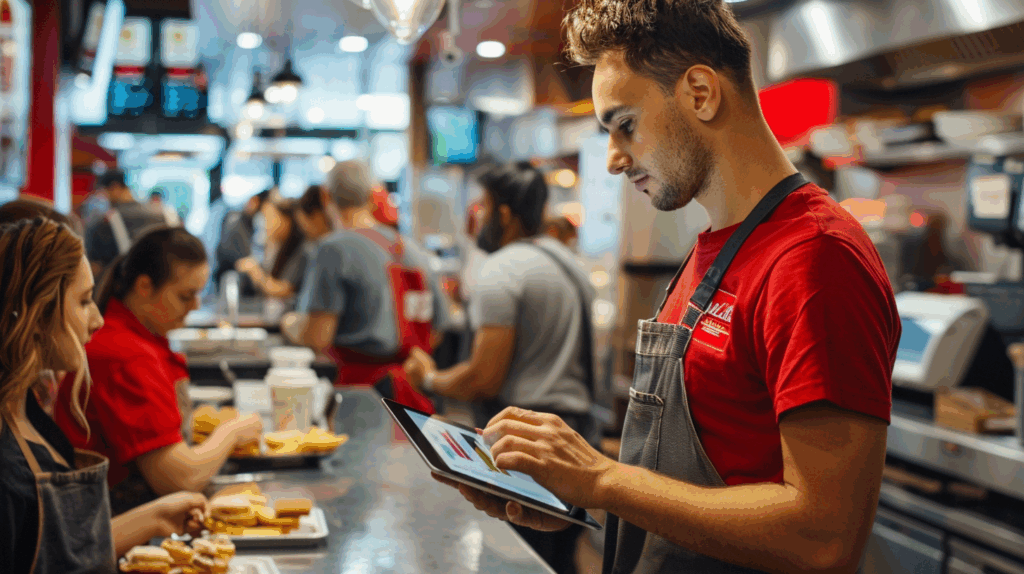
If you’ve ever wished your quick-service restaurant could keep up with the fast pace of customer expectations, you’re not alone. Imagine having the ability to track order times instantly, monitor customer behavior, and spot inefficiencies, all in real-time.
With the right tools and a bit of tech-savvy, optimizing your operations can be as easy. Let’s explore how real-time analytics help QSRs make long waits a thing of the past.
The Power of Real-Time Data in QSRs
Real-time data has become innovative for the restaurant industry. According to the latest CivicScience data, 76% of U.S. adults who eat at fast-food restaurants expect to receive their food within 5 minutes or less. This expectation pressures QSRs to deliver quickly, especially during peak hours. Real-time analytics capabilities embedded in modern systems enable restaurant owners to make data-driven decisions on the spot, addressing bottlenecks that traditional methods might overlook.
QSRs can use real-time data to monitor customer behavior, track order times, and identify inefficiencies that slow down service. For example, data analysis can reveal which menu items are causing delays, allowing restaurant owners to adjust preparation processes or staff allocation in real-time. This proactive approach can lead to faster service and a better customer experience, directly impacting how much revenue a QSR generates during peak periods.
How Data Analysis Drives Service Efficiency
Effective data analysis is the backbone of improving service efficiency. By analyzing real-time data alongside historical data, QSRs can gain insight into patterns and trends impacting service speed. For instance, understanding peak times and the flow of customer orders can help adjust staffing levels or optimize kitchen operations to handle surges in demand.
QSRs can leverage insights derived from data warehouses and data warehousing processes, which can compile information from multiple data sources. This integration of data sources allows for comprehensive restaurant reporting, offering crucial business intelligence.
A restaurant business can use real-time data processing to track when the most revenue is generated during different times of the day. If the data shows a drop in revenue during certain hours, the restaurant owner can investigate further, perhaps adjusting promotional strategies or staffing levels to increase efficiency and boost sales. This type of proactive management is only possible through detailed data analysis.
Leveraging Restaurant Analytics to Minimize Waste
Real-time data enhances customer service and is a powerful tool for minimizing waste in QSRs. By leveraging restaurant analytics, operators can gain insights into consumption patterns, inventory levels, and ordering behaviors. This data is crucial for implementing predictive analytics, allowing restaurants to anticipate demand and reduce overstocking or underutilization of ingredients.
For instance, a cloud-based POS system can track these data points, helping QSRs make more intelligent purchasing and inventory management decisions. This reduces food waste and ensures that popular items are always available, leading to better cost control.
Furthermore, restaurant analytics can be pivotal in managing inventory more efficiently. QSRs can ensure they have the right amount of stock on hand by analyzing data gathered from sales data and supply chain information. This level of precision is crucial for maintaining a high level of service and maximizing revenue.
Leveraging Real-Time Analytics for Competitive Advantage

Real-time analytics allows QSRs to make informed decisions quickly, ensuring they can respond to customer needs and operational challenges in real time. For instance, real-time data allows restaurants to monitor the guest count and adjust operations accordingly. If a sudden influx of customers is detected, additional staff can be deployed to manage the increased demand, minimizing wait times and improving customer service.
Additionally, real-time analytics can help identify opportunities to streamline processes, such as optimizing delivery routes for food delivery services or adjusting menu items based on customer preferences.
The Role of Technology in Real-Time Data Processing
Advanced hardware and software systems make real-time analytics in QSRs possible. Modern cloud-based POS systems have analytics capabilities that allow restaurant owners to process customer data in real-time. For example, a restaurant might use real-time databases to store and process data on customer orders, allowing them to gain insights into customer behavior and adjust their operations accordingly. This data processing capability enables QSRs to respond to changes in business factors, such as shifts in customer demand or supply chain disruptions, with minimal delay.
Moreover, using mobile devices in the restaurant space has further enhanced the ability to collect and analyze real-time data. Employees can access data on the go, allowing them to make quick decisions that improve service speed and customer satisfaction. The ability to process data in real time is a significant advantage for QSRs, whether adjusting the flow of orders in the kitchen or monitoring inventory levels.
Enhancing Customer Experience Through Real-Time Insights
Great customer service is at the core of every successful QSR. Real-time analytics helps restaurants elevate the customer experience by providing key insights into behavior and service efficiency. By tapping into various data streams, QSRs can spot trends affecting customer satisfaction and quickly take action to improve.
For instance, QSRs can quickly detect increasing customer wait times and take corrective measures before frustration sets in. This could involve reconfiguring the order process or tweaking the menu to speed up preparation times. By being responsive to real-time data, QSRs can ensure they meet customer expectations and maintain a high level of service.
FasterLines: Enhancing QSR Efficiency
FasterLines is leading the way in providing real-time analytics solutions tailored to the unique needs of QSRs. By embedding powerful analytics capabilities into their systems, FasterLines offers restaurants a seamless way to improve customer service. Our real-time data processing allows QSRs to adapt instantly when business factors change, whether a sudden surge in orders or a shift in customer preferences.
This flexibility means better managing customer expectations, improving operational efficiency, and minimizing waste. With FasterLines, QSRs can tap into various data sources and leverage advanced analytics systems to stay ahead of the curve and maintain their service speed at its best.
The Future of QSRs Lies in Real-Time Data

Adopting real-time analytics is becoming increasingly essential for QSRs looking to stay competitive as the restaurant industry evolves. By leveraging real-time data and data science capabilities, QSRs can optimize their operations, improve service speed, and enhance the customer experience.
Implementing these technologies helps manage peak times, reduces wait times, and gives restaurant owners the insights they need to make informed business decisions. Whether optimizing inventory, adjusting staffing levels, or refining the customer experience, real-time analytics offers a clear path to success in the quick-service restaurant industry.

